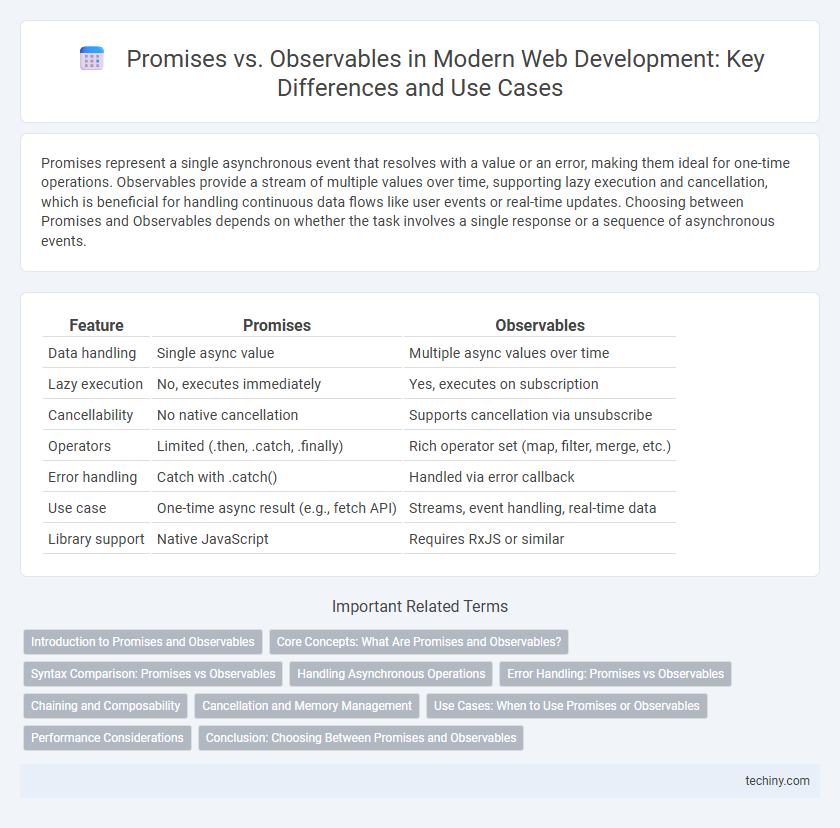Promises represent a single asynchronous event that resolves with a value or an error, making them ideal for one-time operations. Observables provide a stream of multiple values over time, supporting lazy execution and cancellation, which is beneficial for handling continuous data flows like user events or real-time updates. Choosing between Promises and Observables depends on whether the task involves a single response or a sequence of asynchronous events.
Table of Comparison
| Feature | Promises | Observables |
|---|---|---|
| Data handling | Single async value | Multiple async values over time |
| Lazy execution | No, executes immediately | Yes, executes on subscription |
| Cancellability | No native cancellation | Supports cancellation via unsubscribe |
| Operators | Limited (.then, .catch, .finally) | Rich operator set (map, filter, merge, etc.) |
| Error handling | Catch with .catch() | Handled via error callback |
| Use case | One-time async result (e.g., fetch API) | Streams, event handling, real-time data |
| Library support | Native JavaScript | Requires RxJS or similar |
Introduction to Promises and Observables
Promises represent a single future value resulting from an asynchronous operation, providing a cleaner alternative to callback functions by handling success or failure once. Observables offer a more powerful abstraction, capable of emitting multiple values over time, allowing developers to manage streams of asynchronous data with operators for transformation and composition. Understanding the distinction between Promises' single-value resolution and Observables' multi-value streams is essential for effective asynchronous programming in modern web development.
Core Concepts: What Are Promises and Observables?
Promises in web development represent a single asynchronous operation that resolves either successfully or with an error, delivering one value over time. Observables, commonly used with libraries like RxJS, enable multiple asynchronous values to be emitted over time, supporting continuous data streams and reactive programming. Understanding that Promises handle a single future value while Observables manage sequences of values is essential for selecting the right approach in asynchronous JavaScript operations.
Syntax Comparison: Promises vs Observables
Promises in JavaScript use the `.then()` and `.catch()` methods to handle asynchronous operations, returning a single value once resolved or rejected. Observables, provided by libraries like RxJS, use `.subscribe()` to emit multiple values over time, supporting streaming data with operators for complex transformations. Promises are eager and execute immediately, whereas Observables are lazy and only execute upon subscription, offering more flexible syntax for handling sequences.
Handling Asynchronous Operations
Promises provide a single asynchronous value, resolving once and handling success or failure through .then() and .catch() methods, making them ideal for one-time operations. Observables emit multiple values over time, supporting streaming data with operators like map, filter, and take, enabling more complex asynchronous workflows and cancellation capabilities. Choosing between Promises and Observables depends on the need for single versus multiple event handling in asynchronous web development.
Error Handling: Promises vs Observables
In web development, Promises handle errors through a single rejection path using .catch(), which stops execution after the first error occurs, making them suitable for one-time asynchronous operations. Observables provide more robust error handling by allowing multiple values and errors to be emitted over time, with operators like catchError enabling recovery or replacement of error values within a stream. This flexibility makes Observables ideal for complex async scenarios such as real-time data streams where continuous error management is crucial.
Chaining and Composability
Promises provide simple chaining by returning a new Promise from then(), enabling sequential asynchronous operations. Observables support advanced composability through operators like map, mergeMap, and combineLatest, allowing complex data stream transformations and multiple concurrent subscriptions. This makes Observables more flexible for handling real-time or multiple asynchronous events compared to the single-result nature of Promises.
Cancellation and Memory Management
Promises in web development do not support cancellation natively, often leading to potential memory leaks if unresolved operations persist. Observables, widely used in frameworks like Angular, provide built-in cancellation mechanisms through unsubscriptions, enhancing memory management and resource cleanup. This ability to cancel and efficiently manage asynchronous streams makes Observables a more robust choice for complex, long-running operations compared to Promises.
Use Cases: When to Use Promises or Observables
Promises are ideal for single asynchronous operations such as fetching data once from an API or handling a single event, providing a straightforward way to manage success or failure states. Observables excel in handling multiple asynchronous events over time, making them suitable for real-time data streams, user interactions, or complex event sequences in web applications. Choosing between Promises and Observables depends on whether the task requires one-time asynchronous handling or continuous event processing.
Performance Considerations
Promises handle single asynchronous events and resolve once, making them lightweight and efficient for simple tasks with minimal overhead. Observables support multiple emissions over time and provide built-in operators for complex event streams, which can incur higher memory usage and CPU overhead in scenarios with frequent or high-volume data. Choosing between Promises and Observables depends on the performance requirements of handling either single or continuous asynchronous data flows in web applications.
Conclusion: Choosing Between Promises and Observables
Promises offer simplicity and are ideal for handling a single asynchronous operation, making them suitable for straightforward web development tasks. Observables provide powerful capabilities for managing multiple streams of data, event handling, and complex asynchronous workflows, favored in reactive programming environments with frameworks like Angular. Selecting between Promises and Observables depends on the complexity of the task and the need for scalability in asynchronous data handling within web applications.
Promises vs Observables Infographic

 techiny.com
techiny.com